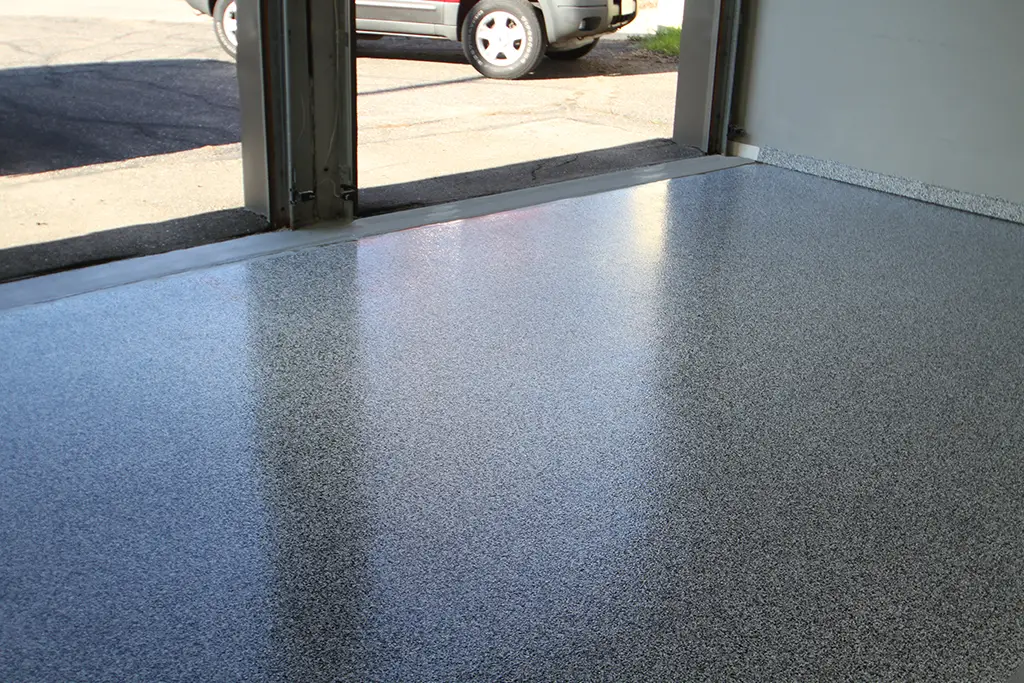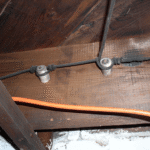Garage floors are often overlooked until there’s a problem. When you’re ready to give your garage floor the attention it needs, you may find yourself thinking about which kind of coating to use: epoxy or polyaspartic.
You may be wondering what the difference is between them or how one compares to the other in terms of durability, pricing, and installation method. Luckily, we can help answer those questions and more.
Table of Contents
What is Epoxy?
Epoxy is a thermosetting material made up of two components: resin and hardener. When it cures, these components chemically react to form a plastic-like material that is highly durable and resistant to chemicals, heat, and moisture. It is available in water-based, solvent-based, and 100% solid varieties.
What is Polyaspartic Floor Coating?

Polyaspartic coatings are an alternative option that has become more popular over recent years. Polyaspartic is made of aliphatic resin, which makes it durable and UV light stable.
Coatings are less prone to damage than epoxy and cure much faster. Some polyaspartic formulations can even be applied in temperatures as low as 20 degrees Fahrenheit, allowing work to be done throughout the winter months in colder climates. For this reason alone, polyaspartic coatings are becoming increasingly popular among homeowners and contractors alike.
Epoxy vs Polyaspartic: What’s the Difference?
When it comes to modern floors, you have a lot of options. Epoxy and polyaspartic coatings are two favorites among commercial and residential spaces, but how can you tell them apart? We’ve created an easy breakdown of their similarities and differences to help you make an informed decision.
Drying Time
After application, it usually takes around 12 to 24 hours for an epoxy coating to dry completely (sometimes longer), depending on the thickness of the layer and the temperature at the time of installation.
On the other hand, polyaspartic coatings dry much faster than epoxy—in fact, most people can walk on them within 6 hours after application. This means that you don’t have to wait as long before you can drive on your garage floor again, put your belongings back in there, or park your car overnight without worrying about damaging the flooring surface.
Durability
Both polyaspartic and epoxy have excellent durability and longevity. When appropriately applied, polyaspartic coatings are about 4 times more durable than epoxy when it comes to resistance to impact, surface wear, chemicals, stains, and weathering. However, there are some situations where epoxy might be a better choice: it’s slightly more resistant to UV light exposure and is slightly more heat-resistant (though both coatings are suitable for most temperature extremes).
Customization
Epoxy has a glossy finish that comes in a variety of colour options. This glossy look can add a level of sophistication to an otherwise plain space. But dont worry, epoxy floors aren’t as slippery as they look.
Polyaspartics offer a more matte finish with added traction and are available in similar colour options to epoxy.
Both epoxy and polyaspartic coatings can be customized to meet your needs. The major difference here is that epoxy must be tinted before it is applied, while polyaspartic can be tinted after the application process is complete.
Application
Epoxy coatings are very thick—about a thousand times thicker than a coat of paint—which requires the use of a special roller to apply them correctly. Polyaspartic coatings are much thinner than epoxies, meaning they can be applied with a standard paint roller. Once applied, there’s also less wait time necessary between coats since they dry faster than epoxies do.
Because polyaspartic cures very quickly, it’s possible to apply multiple layers in a single day—even in cold conditions that would prevent an epoxy coating from curing correctly. The fast-cure feature also means that your floors will be ready for use in less time than with other coatings—which is great.
Price
Although they’re both relatively inexpensive options compared to other types of flooring materials, polyaspartic costs more than epoxy does.
Both options are far more affordable than replacing cracked or damaged concrete flooring.
Epoxy vs Polyaspartic: Pros and Cons
If you’re not sure which floor coating to use on your next project, here are the pros and cons of polyaspartic coatings versus epoxy.
Epoxy Coatings:
Pros: Epoxy is an affordable option for garage floors, with a national average cost of $2-$4 per square foot. It’s durable, stain-resistant, and easy to maintain—just wash it clean with soap and water as needed. Epoxy comes in a variety of colours, so it’s easy to find the right look for your home. In addition, it dries relatively quickly, allowing you to resume normal activity after a few days.
Cons: While epoxy is durable, it’s not as resilient as polyaspartic when exposed to heavy traffic or frequent spills. It may require resealing every few years to maintain its appearance and lifespan.
The curing process takes longer (typically about 24 hours), with higher temperatures speeding up the process.
Polyaspartic:

Pros: Polyaspartic cures much faster than epoxy—so it can be applied more quickly and installed in less time. This means that your space will be ready for use again much sooner after installation. Polyaspartic also offers great chemical resistance, making it ideal for locations that need durable flooring, as well as places where chemicals or other substances may spill on the floor (like garages). It’s also UV stable, so it doesn’t discolour like epoxy does when exposed to light.
Cons: They’re more expensive than epoxies.
Epoxy vs Polyaspartic: Which One is Better?
As a homeowner, you want something that’s going to last a long time and look good, but you also want something that’s easy to maintain and won’t break the bank.
When you want a durable, beautiful finish that will stand up to chemicals and withstand heavy traffic, you’re ultimately going to end up choosing between epoxy and polyaspartic. Both coatings have many benefits, but they also have specific uses that make one better than the other. If you’re looking at getting a new floor coating, it’s important to know the differences between epoxy and polyaspartic, so you can make the right choice.


